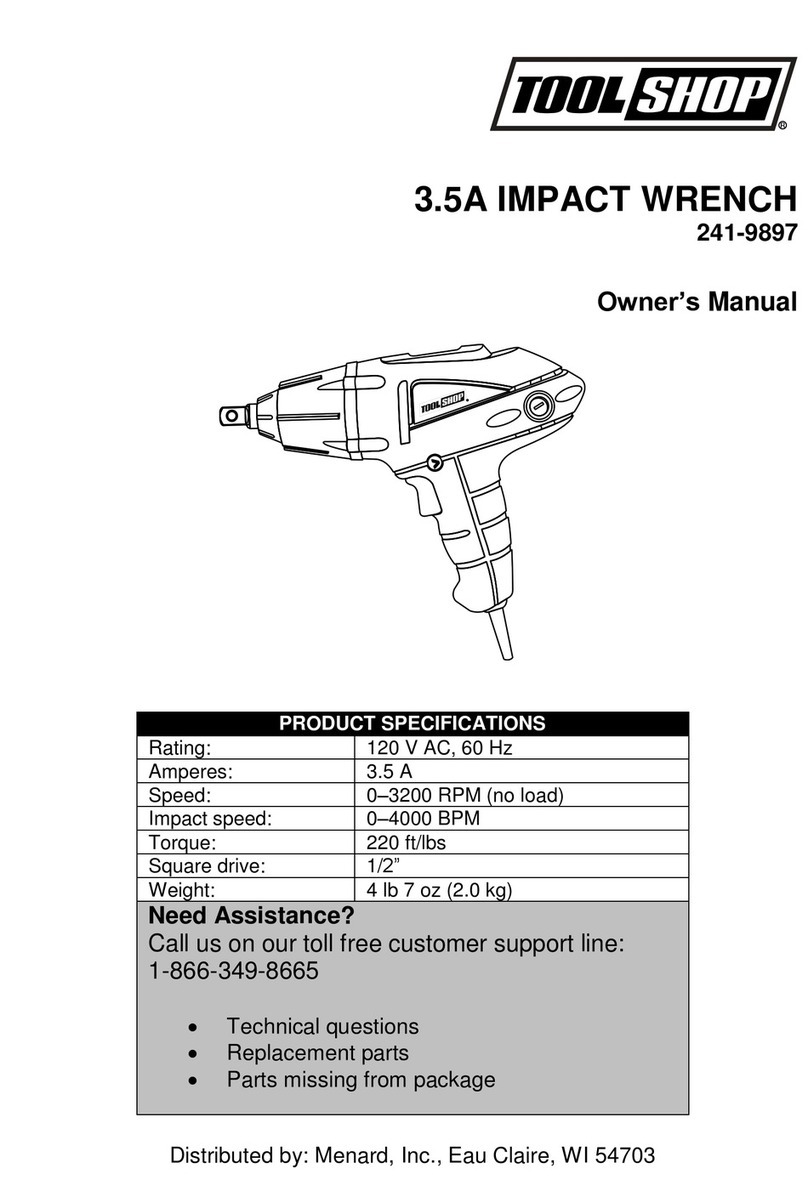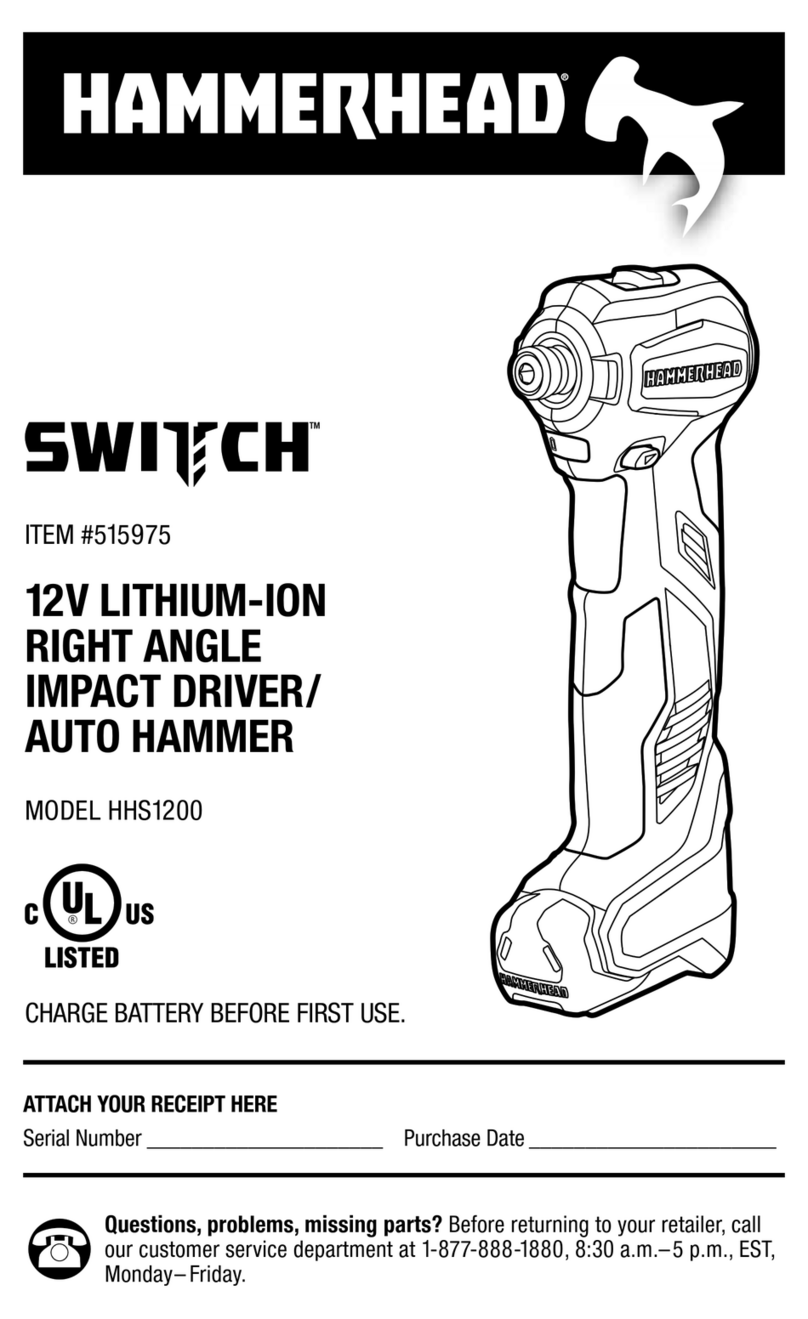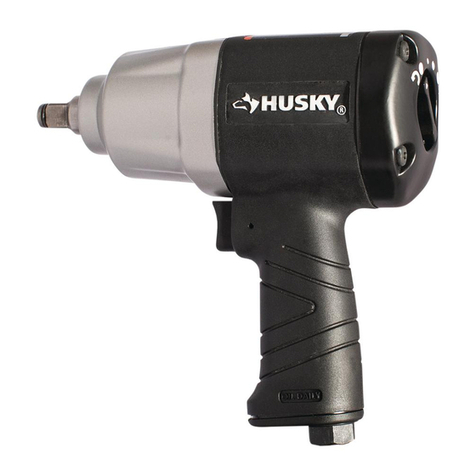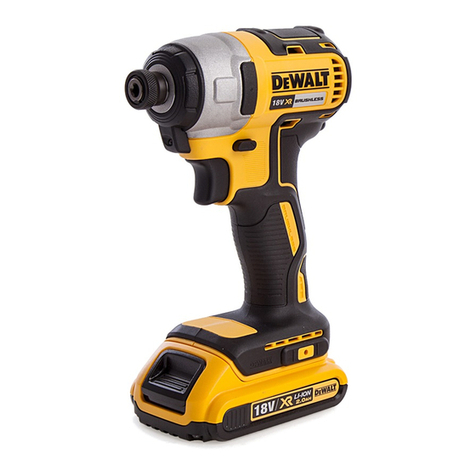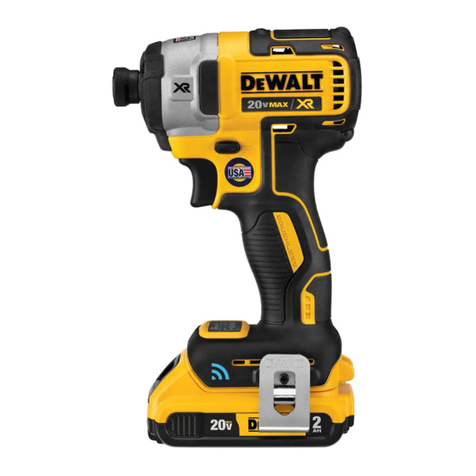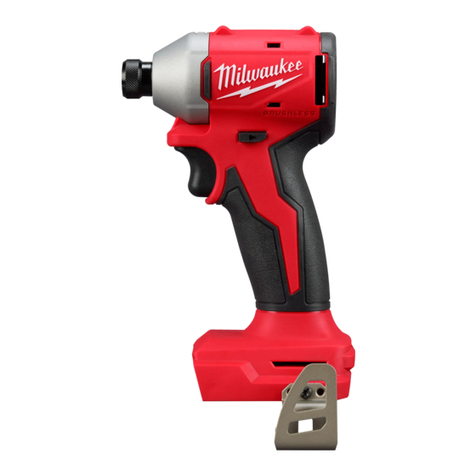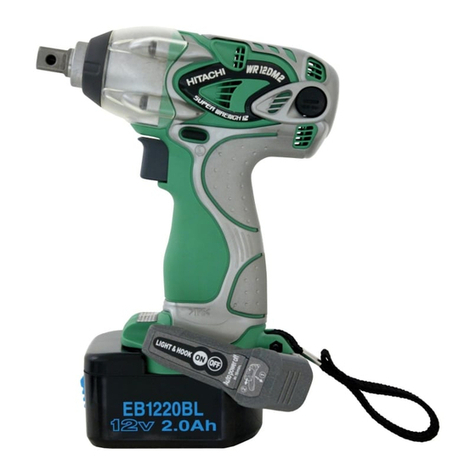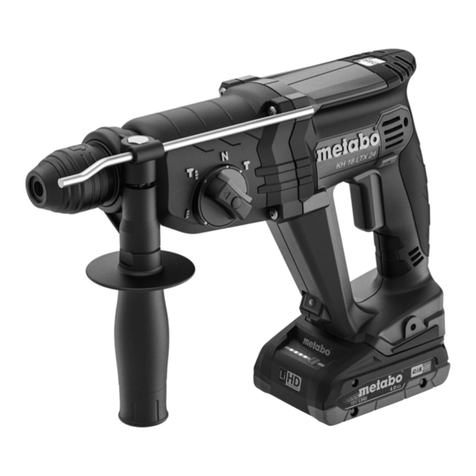Toolshop 241-9031 User manual

18 VOLT LI-ION IMPACT WRENCH
241-9031
Owner’s Manual
PRODUCT SPECIFICATIONS
IMPACT WRENCH
Speed:
0–2,200 RPM (no load)
Impact speed:
0–2,900 BPM
Torque:
300 ft/lbs (Max. torque)
Square drive:
1/2"
For questions / comments, technical assistance or repair parts –
Please Call Toll Free at: 1-866-349-8665 (M–F 9am –5pm EST)
Or email us at: customerservice@powertoolsplus.ca

2
Product specifications ………….………………………………………………………………...
1
Table of contents ……………………………………………………………………..................
2
General safety warnings …………………………………………………………………………
3–4
Eye, ear & lung protection ……………………………………………………………………….
3–4
Electrical safety …………………………………………………………………………………...
4
Power tool safety ……………………………………………………………………..................
5–6
General safety rules ……………………………………………………………………………...
5
Work area ………………………………………………………………….……………………...
5
Electrical safety …………………………………………………………………………………...
5
Personal safety …………………………………………………………………………………...
5
Power tool use and care .………………………………………………………………………..
6
Battery tool use and care ………………………………………………………………………..
6
Service …………………………………………………………………………………………….
6
Specific safety rules ……………………………………………………………………………...
7
Battery & charger safety ………………………………………………………….……………...
8
Battery pack recycling ……………………………………………………………………………
8
Symbols ……………………………………………………………………………………………
9
Know your impact wrench ……………………………………………………………………….
10
Assembly and operating …………………………………………………………………………
11–14
Charging the battery pack ……………………………………………………………………….
11
Installing a battery pack in the impact wrench ………………………………………………...
11
Installing impact sockets …………………………………………………………………………
12
Forward/reverse switch ………………………………………………………………………….
12
Variable-speed trigger switch …………………………………………………………………...
12
LED worklight ……………………………………………………………………………………..
13
Removing fasteners ……………………………………………………………………………...
13–14
Maintenance ………………………………………………………………………………………
15
General maintenance …………………………………………………………………………….
15
Lubrication ………………………………………………………………………………………...
15
Battery pack removal and preparation for recycling ………………………………………….
15
Exploded view …………………………………………………………………………………….
16
Parts list ……………………………………………………………………………………………
17
Warranty ……………………………………………………………………….………………….
18
TABLE OF CONTENTS

3
EYE, EAR & LUNG PROTECTION
This instruction manual includes the following:
General Safety Rules
Specific Safety Rules and Symbols
Functional Description
Assembly
Operation
Maintenance
Accessories
!
ALWAYS WEAR EYE PROTECTION THAT CONFORMS WITH CSA
REQUIREMENTS or ANSI SAFETY STANDARD Z87.1
FLYING DEBRIS can cause permanent eye damage. Prescription
eyeglasses ARE NOT a replacement for proper eye protection.
WARNING: Non-compliant eyewear can cause serious injury if
broken during the operation of a power tool.
WARNING: Use hearing protection, particularly during extended
periods of operation of the tool, or if the operation is noisy.
!
GENERAL SAFETY WARNINGS
WARNING: Before using this tool or any of its accessories, read this
manual and follow all Safety Rules and Operating Instructions. The important
precautions, safeguards and instructions appearing in this manual are not
meant to cover all possible situations. It must be understood that common
sense and caution are factors which cannot be built into the product.
!
SAVE THESE INSTRUCTIONS FOR REFERENCE

4
ELECTRICAL SAFETY
GENERAL SAFETY WARNINGS
WEAR A DUST MASK THAT IS DESIGNED TO BE USED WHEN
OPERATING A POWER TOOL IN A DUSTY ENVIRONMENT.
WARNING: Dust that is created by power sanding, sawing, grinding,
drilling, and other construction activities may contain chemicals that are
known to cause cancer, birth defects, or other genetic abnormalities. These
chemicals include:
Lead from lead-based paints
Crystalline silica from bricks, cement, and other masonry products
Arsenic and chromium from chemically treated lumber
The level of risk from exposure to these chemicals varies, according to how
often this type of work is performed. In order to reduce exposure to these
chemicals, work in a well-ventilated area, and use approved safety
equipment, such as a dust mask that is specifically designed to filter out
microscopic particles.
!
WARNING: To avoid electrical hazards, fire hazards or damage to the
tool, use proper circuit protection.
This tool is wired at the factory for 120 V AC operation. It must be
connected to a 120 V AC, 15 A circuit that is protected by a time-delayed
fuse or circuit breaker. To avoid shock or fire, replace power cord
immediately if it is worn, cut or damaged in any way.
SAVE THESE INSTRUCTIONS FOR REFERENCE
WARNING: Ventilation openings in batteries and chargers must always be
open to allow cooling air to circulate freely. Air vents that are blocked,
restricted or covered may result in the battery or charger overheating.
Overheating may lead to damage to the tool or cause a fire, resulting in
possible serious injury.
!

5
WARNING: Read all safety warnings
and instructions. Failure to follow the warnings
and instructions may result in electric shock, fire
and/or serious injury.
Save all warnings and instructions for future
reference.
Work area safety
Keep work area clean and well lit. Cluttered or
dark areas invite accidents.
Do not operate power tools in explosive
atmospheres, such as in the presence of
flammable liquids, gases or dust. Power tools
create sparks which may ignite the dust or
fumes.
Keep children and bystanders away while
operating a power tool. Distractions can cause
you to lose control.
Electrical safety
Power tool plugs must match the outlet.
Never modify the plug in any way. Do not
use any adapter plugs with earthed
(grounded) power tools. Unmodified plugs and
matching outlets will reduce risk of electric
shock.
Avoid body contact with earthed or
grounded surfaces such as pipes, radiators,
ranges and refrigerators. There is an
increased risk of electric shock if your body is
earthed or grounded.
Do not expose power tools to rain or wet
conditions. Water entering a power tool will
increase the risk of electric shock.
Do not abuse the cord. Never use the cord
for carrying, pulling or unplugging the power
tool. Keep cord away from heat, oil, sharp
edges or moving parts. Damaged or
entangled cords increase the risk of electric
shock.
When operating a power tool outdoors, use
an extension cord suitable for outdoor use.
Use of a cord suitable for outdoor use reduces
the risk of electric shock.
If operating a power tool in a damp location
is unavoidable, use a residual current device
(RCD) protected supply. Use of a ground fault
circuit interrupter (GFCI) reduces the risk of
electric shock.
Personal safety
Stay alert, watch what you are doing and use
common sense when operating a power tool.
Do not use a power tool while you are tired
or under the influence of drugs, alcohol or
medication. A moment of inattention while
operating power tools may result in serious
personal injury.
Use personal protective equipment. Always
wear eye protection. Protective equipment
such as dust mask, non-skid safety shoes, hard
hat, or hearing protection used for appropriate
conditions will reduce personal injuries.
Prevent unintentional starting. Ensure the
switch is in the off-position before
connecting to power source and/or battery
pack, picking up or carrying the tool.
Carrying power tools with your finger on the
switch or energizing power tools that have the
switch on invites accidents.
Remove any adjusting key or wrench before
turning the power tool on. A wrench or a key
left attached to a rotating part of the power tool
may result in personal injury.
Do not overreach. Keep proper footing and
balance at all times. This enables better
control of the power tool in unexpected
situations.
Dress properly. Do not wear loose clothing
or jewelry. Keep your hair, clothing and
gloves away from moving parts. Loose
clothes, jewelry or long hair can be caught in
moving parts.
If devices are provided for the connection of
dust extraction and collection facilities,
ensure these are connected and properly
used. Use of dust collection can reduce dust-
related hazards.
POWER TOOL SAFETY
!

6
Power tool use and care
Do not force the power tool. Use the correct
power tool for your application. The correct
power tool will do the job better and safer at the
rate for which it was designed.
Do not use the power tool if the switch does
not turn it on and off. Any power tool that
cannot be controlled with the switch is
dangerous and must be repaired.
Disconnect the plug from the power source
and/or the battery pack from the power tool
before making any adjustments, changing
accessories, or storing power tools. Such
preventive safety measures reduce the risk of
starting the power tool accidentally.
Store idle power tools out of the reach of
children and do not allow persons unfamiliar
with the power tool or these instructions to
operate the power tool. Power tools are
dangerous in the hands of untrained users.
Maintain power tools. Check for
misalignment or binding of moving parts,
breakage of parts and any other condition
that may affect the power tool’s operation. If
damaged, have the power tool repaired
before use. Many accidents are caused by
poorly maintained power tools.
Keep cutting tools sharp and clean. Properly
maintained cutting tools with sharp cutting
edges are less likely to bind and are easier to
control.
Use the power tool, accessories and tool bits
etc. in accordance with these instructions,
taking into account the working conditions
and the work to be performed. Use of the
power tool for operations different from those
intended could result in a hazardous situation.
Hold power tool by insulated gripping
surfaces, when performing an operation
where the fastener may contact hidden
wiring or its own cord. Fasteners contacting a
"live" wire may make exposed metal parts of the
power tool "live" and could give the operator an
electric shock.
Battery tool use and care
Recharge only with the charger specified by
the manufacturer. A charger that is suitable for
one type of battery pack may create a risk of fire
when used with another battery pack.
Use power tools only with specifically
designated battery packs. Use of any other
battery packs may create a risk of injury and
fire.
When battery pack is not in use, keep it away
from other metal objects, like paper clips,
coins, keys, nails, screws or other small
metal objects that can make a connection
from one terminal to another. Shorting the
battery terminals together may cause burns or a
fire.
Under abusive conditions, liquid may be
ejected from the battery; avoid contact. If
contact accidentally occurs, flush with water.
If liquid contacts eyes, additionally seek
medical help. Liquid ejected from the battery
may cause irritation or burns.
Service
Have your power tool serviced by a qualified
repair person using only identical
replacement parts. This will ensure that the
safety of the power tool is maintained.
POWER TOOL SAFETY

7
WARNING: Know your impact wrench.
Do not plug in the charger or install the
battery in the tool until you have read and
understand this Instruction Manual. Learn
the tool’s applications and limitations, as
well as the specific potential hazards related
to this tool. Following this rule will reduce the
risk of electric shock, fire, or serious injury.
Always wear eye protection. Any
power tool can throw foreign
objects into your eyes and cause
permanent eye damage.
ALWAYS wear safety goggles (not glasses) that
comply with ANSI safety standard Z87.1.
Everyday glasses have only impact resistant
lenses. They ARE NOT safety glasses.
WARNING: Glasses or goggles not in
compliance with ANSI Z87.1 could cause
serious injury when they break.
WARNING: Always use hearing
protection when operating the impact
wrench.
Use only impact sockets and accessories that
are designed for use with an impact wrench. Do
not use chrome plated sockets and accessories.
Chrome plated sockets and accessories are
designed for hand use only and MUST NOT be
used with an impact wrench. They may shatter
and possibly cause serious injury.
Before each use, check the impact sockets and
accessories for excessive wear or cracks. Worn
or damaged sockets or accessories may shatter
and possibly cause serious injury. Worn
accessories may allow the socket to come off
during operation of the impact wrench.
After installing any accessory in the hex drive,
pull outward on the accessory to ensure it is
properly installed and cannot be pulled out of
the hex drive.
Never use the impact wrench as a torque
wrench. Always use a torque wrench to adjust
the fastener to the specified torque.
Keep the impact wrench handle and body clean
and free of oil and grease. Always use a clean
dry cloth when cleaning. Do not use solvents,
brake fluid, gasoline or other petroleum products
to clean the tool. They will damage the tool.
Do not wear neckties or loose clothing.
When wearing gloves, they must be tight fitting
and slip resistant type. Leather gloves offer the
best protection.
Always use two hands when operating the
impact wrench. Use one hand on the handle
and the other on the front of the tool body.
Never place your hand so it is touching the
socket or accessory when the tool is turned ON.
Your hand could be seriously injured.
Always remove the battery from the tool before
installing or removing any socket or accessory.
Be ready for components to shift when removing
any fastener. The speed of the fastener removal
could cause unexpected shifting of the
components.
SPECIFIC SAFETY RULES
SAVE THESE INSTRUCTIONS FOR REFERENCE
!
!
!

8
WARNING: Only use the charger
supplied with this kit to charge the 18V
battery. Charging any other batteries may
damage the charger and possibly cause
serious injury.
Do not store or carry the battery in a manner in
which metal objects could contact the exposed
metal end. Do not place the battery in aprons,
pockets, drawers, etc. with loose nails, screws,
keys etc. The battery could short circuit causing
a fire, personal injury or damage to the battery.
Never attempt to open the battery for any
reason. If the housing of the battery breaks or
cracks, immediately discontinue use and do not
recharge.
Do not charge the battery if it is wet or shows
any evidence of corrosion.
A small leakage from the battery may occur
under extreme usage, charging or temperature
conditions. This does not indicate a failure.
However, if the outer seal is broken and this
leakage gets on your skin, follow these steps:
1. Wash immediately with soap and water.
2. Neutralize with a mild acid such as lemon
juice or vinegar.
3. If liquid gets into your eyes, flush
immediately with clean water for a
minimum of 10 minutes and seek medical
attention.
NOTE: The battery liquid is slightly acidic.
Do not incinerate the battery. It can explode in a
fire.
Do not use an extension cord. Plug the charger
cord directly into an electrical outlet.
Use the charger only in a standard
120V, 60 Hz electrical outlet.
Do not use the charger in wet or damp
conditions. It is intended for indoor use only. Do
not use the charger near sinks or tubs. Do not
immerse the charger in water.
Do not allow the cord to hang over the edge of a
table or counter or touch hot surfaces. The
charger should be placed away from sinks and
hot surfaces.
Do not use the charger to charge any batteries
other than the cordless drill batteries. Other
batteries may explode.
Do not allow the cord to hang over the edge of a
table or counter or touch hot surfaces. The
charger should be placed away from sinks and
hot surfaces.
Do not operate charger if the cord or plug is
damaged. Replace the damaged cord and plug
immediately.
Do not operate the charger if it has received a
sharp blow, been dropped or otherwise
damaged in any way. Have a qualified
technician examine the charger and repair it if
necessary. Do not disassemble the charger.
Do NOT charge the batteries when the work
area or the battery temperature is at or below 0°
C (32° F) or above 45° C (113° F).
Unplug the charger when not in use and before
cleaning or maintenance.
BATTERY PACK RECYCLING
To preserve our natural resources, please
recycle or dispose of batteries properly.
The batteries charged by this charger may
contain chemicals and metals that are harmful
to the environment. Never dispose of re-
chargeable batteries in your normal household
garbage or in landfill sites as they will add to the
pollution of the environment.
BATTERY & CHARGER SAFETY
SAVE THESE INSTRUCTIONS FOR REFERENCE
!

9
3042597
JD5087
This symbol designates that this tool is listed
with U.S. requirements by
ETL Testing Laboratories, Inc.
Conforms to UL Std. 60745-1 and 60745-2-2.
V
Volts
A
Amperes
Hz
Hertz
W
Watts
kW
Kilowatts
Microfarads
L
Liters
kg
Kilograms
H
Hours
N/cm2
Newtons per square
centimeter
Pa
Pascals
OPM
Oscillations per minute
Min
Minutes
S
Seconds
or a.c.
Alternating current
Three-phase alternating
current
Three-phase alternating
current with neutral
Direct current
No load speed
Alternating or direct
current
Class II construction
Splash-proof
construction
Watertight construction
Protective grounding at
grounding terminal,
Class I tools
Revolutions or
reciprocations per
minute
Diameter
Off position
Directional arrow
Warning symbol
Wear your safety
glasses
Wear your hearing
protection
SYMBOLS
WARNING: Some of the following symbols may appear on the impact wrench.
Study these symbols and learn their meaning. Proper interpretation of these symbols
will allow for more efficient and safer operation of this tool.
!

10
KNOW YOUR IMPACT WRENCH
BATTERY & CHARGER SPECIFICATIONS
Battery:
18 V Li-ion, 4.0 Ah
Replacement battery:
JDB180Li
Optional replacement battery:
236-9028
Replacement charger assembly:
DL1104118
Battery charger
Green
LED
Red
LED
Air
vents
LED worklight
Forward /
reverse switch
Battery
1/2"
square drive
Air vents
Variable speed
trigger switch
Battery release
button

11
CHARGING THE BATTERY PACK
1. Place the battery charger (1) in a dry
location near a 120 V 60 Hz electrical
outlet (Fig. 1).
2. Plug the battery pack (2) into the 120 V 60
Hz wall receptacle.
NOTE: The GREEN LED (3) on the battery
charger will turn ON indicating the power
supply is “live”. The RED LED (4) will
remain OFF.
3. Insert the battery pack stem (5) into the
battery charger cavity (6).
NOTE: Make sure the battery stem is
pressed fully into the battery charger
cavity.
NOTES:
a) The battery pack should only be charged in
an area where the temperature is between
32–113°F (0–45°C).
b) During the charging cycle, the GREEN LED
will turn OFF and the RED LED will flash
indicating the battery pack is being charged.
NOTE: If the RED LED does not flash, check to
make sure battery pack stem is pressed fully
into the battery charger cavity and the electrical
outlet is “live”. If the RED LED still does not
flash, the battery pack may be too hot or too
cold to be charged or it may be defective.
c) It is normal for the battery charger to be warm
to the touch during operation.
d) When the battery pack is fully charged, the
RED LED will turn OFF and the GREEN LED
will turn ON.
e) Remove the battery charger plug from the
wall receptacle and remove the battery pack
from the battery charger once the battery pack
is fully charged.
WARNING: If the charger is used with a
power bar or extension cord, it must be
placed in a well ventilated area and NOT in
contact with any combustible material.
INSTALLING THE BATTERY PACK IN THE
IMPACT WRENCH
1. Remove the discharged battery pack (1)
from the tool by pressing the battery
release buttons (2) on each side of the
battery pack and pulling the battery pack
out of the tool handle (3) (Fig. 2).
2. Insert the fully charged battery pack into
the matching slots in the tool handle where
the discharged battery pack has been
removed.
NOTE: The battery release buttons will
“click” into place when the battery pack is
fully installed.
WARNING: Do not immerse battery
pack in water. Sudden cooling could cause a
hot battery to explode or leak.
Fig. 1
1
2
3
4
5
6
ASSEMBLY AND OPERATING
!
!
Fig. 2
3
2
1

12
Fig. 3
INSTALLING IMPACT SOCKETS
WARNING: Use only impact sockets
and accessories that are designed for use
with an impact wrench. Do not use chrome
plated sockets and accessories. Chrome plated
sockets and accessories are designed for hand
use only and MUST NOT be used with an
impact wrench. They may shatter and possibly
cause serious injury.
WARNING: Always remove the battery
from the tool before changing any sockets or
accessories. You may injure your hand if the
tool is started accidentally.
To install a socket, press the square portion of
the socket (1) onto the square drive (2) of the
impact wrench (Fig. 3).
NOTE: Slide the socket fully onto the square
drive so the socket retainer (3) will hold the
socket firmly in place.
FORWARD/REVERSE SWITCH
This impact wrench is equipped with a
forward/reverse switch (1) (Fig. 4).
1. To operate the impact wrench in the
reverse direction, press the
forward/reverse switch to the RIGHT. This
direction of rotation will loosen the
fastener.
2. To operate the impact wrench in the
forward direction, press the
forward/reverse switch to the LEFT. This
direction of rotation will tighten the
fastener.
NOTE: Never press the forward/reverse
switch while the impact wrench it turned
ON. Damage to the tool will result.
VARIABLE SPEED TRIGGER SWITCH
This impact wrench is equipped with a variable
speed ON/OFF trigger switch.
1. To start the impact wrench, gently squeeze
the trigger switch (2) (Fig. 5).
NOTE: The impact wrench will turn at its
slowest speed when the trigger switch is
depressed slightly. The impact wrench will
turn at its fastest speed when the trigger
switch is fully depressed.
2. To stop the impact wrench, release the
trigger switch.
NOTE: Never allow your hand to cover the
air vents of the impact wrench. Running the
tool at slow speeds will cause it to heat up.
If the tool gets warm while running at slow
speeds, stop and allow it to cool.
ASSEMBLY AND OPERATING
!
!
Fig. 4
Fig. 5

13
LED WORKLIGHT
The LED worklight (1) will automatically turn ON
when the trigger switch is squeezed (Fig. 6). It
will automatically turn OFF when the trigger
switch is released.
REMOVING FASTENERS
One of the most common uses for the impact
wrench is to remove car wheel nuts for rotating
the tires. Car wheel nut removal is used for
illustrative purposes.
DANGER: Before attempting to remove
a car wheel, make sure all jacking, wheel
blocking and wheel removal safety
procedures illustrated in the Owner’s Manual
for your car are followed exactly. Failure to
follow those safety instructions could result
in serious injury or death.
1. Install the correct size of impact socket on
the impact wrench (Fig. 3).
2. Set the forward/reverse button to the
RIGHT for removing fasteners (Fig. 4).
3. Insert the battery in the tool (Fig. 2).
4. Grasp the impact wrench handle (1) with
one hand and the front housing of the
impact wrench (2) with the other hand
(Fig. 7).
5. Place impact socket (3) onto the wheel nut.
NOTE: Make sure the socket is fully
engaged with the nut to avoid potentially
damaging the socket or the wheel nut.
6. While holding the tool level with the ground
and with a firm grasp, squeeze the trigger
switch (4).
For safety reasons, the operator must
read the sections of this Owner’s Manual
entitled "GENERAL SAFETY
WARNINGS", "POWER TOOL SAFETY",
"SPECIFIC SAFETY RULES", "BATTERY
AND CHARGER SAFETY" and
"SYMBOLS" before using this impact
wrench.
Verify the following every time the impact
wrench is used:
1. Safety glasses and hearing
protection are being worn.
2. Socket or accessory is "impact
wrench"rated.
3. Socket or accessory is in good
condition.
Failure to observe these safety rules will
significantly increase the risk of injury.
WARNING
!
!
!
ASSEMBLY AND OPERATING
Fig. 6
1

14
REMOVING FASTENERS –cont’d
When removing fasteners, do not allow the
impact wrench to operate more than 15 seconds
unless the fastener begins to turn. If the fastener
fails to turn within 15 seconds, reverse the
direction of rotation and operate the impact
wrench in a forward direction on the fastener for
a few seconds. Now switch back to reverse
direction and remove the fastener. This
procedure will usually break loose seized or
"frozen" fasteners.
WARNING: Operating the impact wrench for
more that 15 seconds at a time on a seized or
"frozen" fastener may break the fastener. It will
also place severe stress on the impact wrench
and possibly damage the tool.
ASSEMBLY AND OPERATING
!
Fig. 7

15
GENERAL
WARNING: When servicing, use only
identical replacement parts. The use of any
other part may create a hazard or cause
product damage.
DO NOT use solvents when cleaning plastic
parts. Plastics are susceptible to damage from
various types of commercial solvents and may
be damaged by their use. Use a clean cloth to
remove dirt, dust, oil, grease etc.
WARNING: Do not allow brake fluids,
gasoline, petroleum-based products,
penetrating oils, etc. to come into contact
with plastic parts. They contain chemicals
that can damage, weaken or destroy plastic.
DO NOT abuse power tools. Abusive practices
can damage the tool and the workpiece.
WARNING: DO NOT attempt to modify
tools or create accessories. Any such
alteration or modification is misuse and
could result in a hazardous condition leading
to possible serious injury. It will also void
the warranty.
LUBRICATION
All of the bearings in this tool are lubricated with
a sufficient amount of high-grade lubricant for
the life of the unit under normal conditions.
Therefore, no further lubrication is required.
BATTERY PACK REMOVAL AND
PREPARATION FOR RECYCLING
To preserve our natural resources, please
recycle or dispose of batteries properly.
The batteries accompanying this tool may
contain chemicals and metals that are harmful
to the environment. Never dispose of
rechargeable batteries in your normal household
garbage or in landfill sites, because they will add
to the pollution of the environment.
Consult your local waste authority for
information regarding available recycling and
disposal options.
WARNING: Upon removal of the battery
pack, cover the terminals of the battery pack
with electrical tape or heavy-duty adhesive
tape. Never touch both terminals with metal
objects or body parts, because a short
circuit may result. Keep away from children.
Do not attempt to destroy or disassemble
battery pack or remove any of its
components. Rechargeable batteries must
be recycled or disposed of properly. Failure
to comply with these warnings could result
in fire and serious injury.
MAINTENANCE
!
!
!
!

16
EXPLODED VIEW

17
WARNING: When servicing, use only original equipment replacement parts. The use of
any other parts may create a safety hazard or cause damage to the tool.
Any attempt to repair or replace electrical parts on this tool may create a safety hazard unless
repairs are performed by a qualified technician. For more information, call the Toll-free Helpline,
at 1-866-349-8665.
Always order by PART NUMBER, not by key number.
!
Key #
Part #
Part Name
Quantity
1
4030010114
ST3.9X25
4
2
2020050074
4mm spring washer
4
3
2010080012
Protective rubber sleeve
1
4
3140020017
Aluminum gear housing
1
5
4080070001
O-ring
1
6
2040200009
Anvil shaft bushing
1
7
2040050114
Washer 1
1
8
2030020034
Anvil shaft
1
9
4110050003
Ball ∅5.5
1
10
2010010027
Impact block
1
11
4010010084
Ball ∅4
24
12
2030020229
Washer 2
2
13
2050060032
Torque spring
1
14
2040050022
Main drive shaft
1
15
2030020035
Planetary shafts
3
16
4080040001
Planetary gears
3
17
1030130002
Washer 3
1
18
3150070078
Bearing 6002 2RS
1
19
2010180050
Inner gear ring
1
20
4040030003
M5X10
2
21
2010090067
5mm spring washer
2
22
1060050017
Rubber bumpers
2
23
4040030001
Gear box
1
24
3140100010
Motor pinion gear
1
25
4020010015
Motor
1
26
3140020108
Housing
1
27
3010020030
M3X4
1
28
4020010030
Heat sink
1
29
2020180010
Speed switch
1
30
3120030124
Forward/reverse button
1
31
1180060005
Battery connector assembly
1
32
4030010106
ST3.9X19
1
33
4030010098
ST3.9X13
1
34
4030010098
LED circuit board
1
35
JDB517918
Battery pack
1
PARTS LIST

18
Rev 1.4 29/07/2020
Distributed by: Menard, Inc., Eau Claire, WI 54703
TOOL SHOP®18 VOLT IMPACT WRENCH WARRANTY
1-YEAR LIMITED WARRANTY:
This TOOL SHOP®brand power tool carries a 1-Year Limited Warranty to the
original purchaser. If the tool fails within one (1) year from the date of purchase,
simply bring this tool with your original sales receipt back to your nearest
MENARDS®retail store. At its discretion, TOOL SHOP®agreesto have the
tool replaced with the same or similar TOOL SHOP®product free of charge,
within the stated warranty period, when returned by the original purchaser with
original sales receipt. Notwithstanding the foregoing,this limited warranty does
not cover any damage that has resulted from abuse or misuse of the
Merchandise. This warranty: (1) excludes expendable parts including but not
limited to blades, belts, bits, light bulbs, and/or batteries; (2) shall be void if this
tool is used for commercial and/or rental purposes; and (3) does not cover any
losses, injuries to persons/property or costs. This warranty does give you
specific legal rights and you may have other rights, which vary from state to state.
Be careful, tools are dangerous if improperly used or maintained. Seller’s
employees are not qualified to advise you on the use of this Merchandise. Any
oral representation(s) made will not be binding on seller or its employees. The
rights underthis limited warranty are tothe original purchaser of the Merchandise
and may not be transferred to any subsequent owner. This limited warranty is in
lieu of all warranties, expressed or implied including warranties or merchantability
and fitness for a particular purpose. Seller shall not be liable for any special,
incidental, or consequential damages. The sole exclusive remedy against the
seller will be for the replacement of any defects as provided herein, as long as
the seller is willing or able to replace this product or is willing to refund the
purchase price as provided above. For insurance purposes, seller is not allowed
to demonstrate any of these powertools for you.
For questions/ comments, technical assistance or repair parts –
Please calltoll free at: 1-866-349-8665 (M-F 8am –6pm)
SAVE YOUR RECEIPTS. THIS WARRANTY IS VOID WITHOUT THEM.
Table of contents
Other Toolshop Impact Driver manuals
Popular Impact Driver manuals by other brands

Ingersoll-Rand
Ingersoll-Rand 2131A instructions

Makita
Makita DTD171 instruction manual
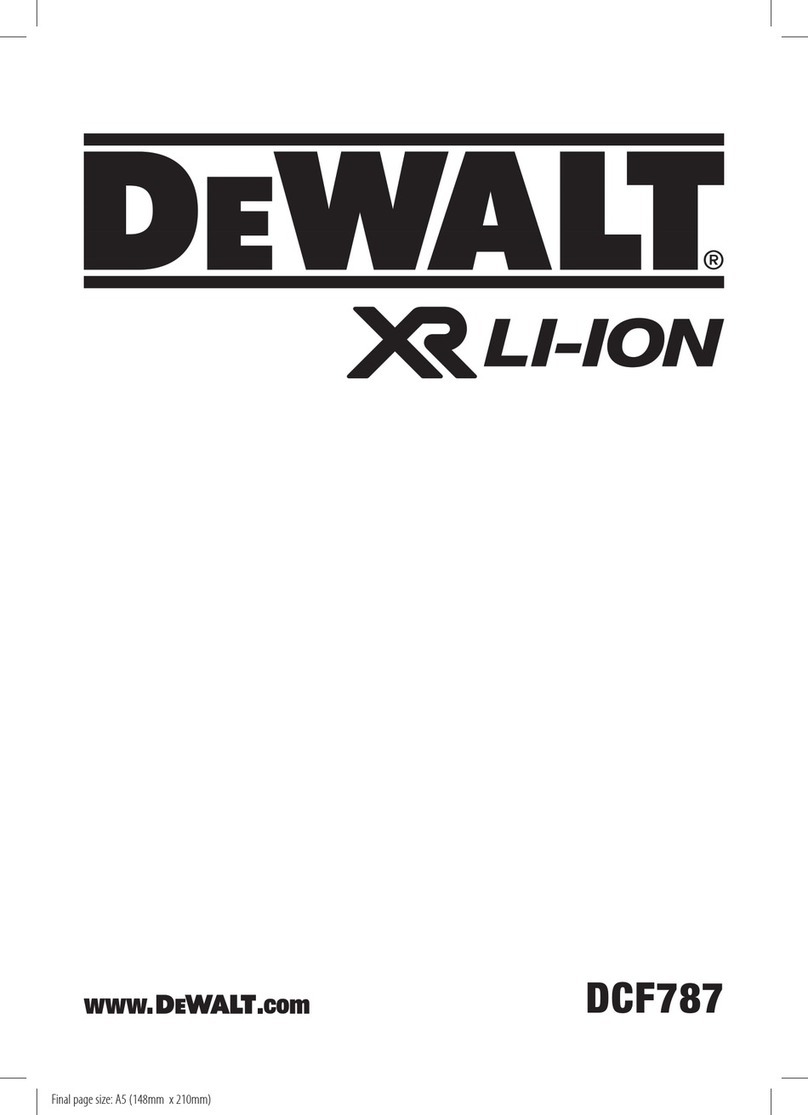
DeWalt
DeWalt DCF787N-XJ Original instructions
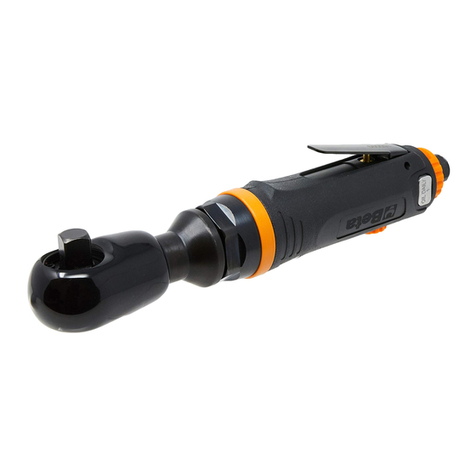
Beta
Beta 019210025 Operation manual and instructions
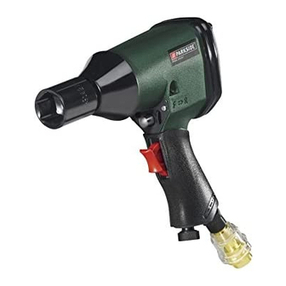
Parkside
Parkside PDSS 310 A1 operation and safety notes original operating instructions

Milwaukee
Milwaukee M18 FUEL 2769-22 Operator's manual
